If you’re interested in the history of ordinary people in a fishing village at the end of the island, then Glencolumbcille Folk Village is the place for you.
But even if you’re less interested in history, this pretty little open-air museum village is well worth a visit!
Page Contents (click line to jump the text)
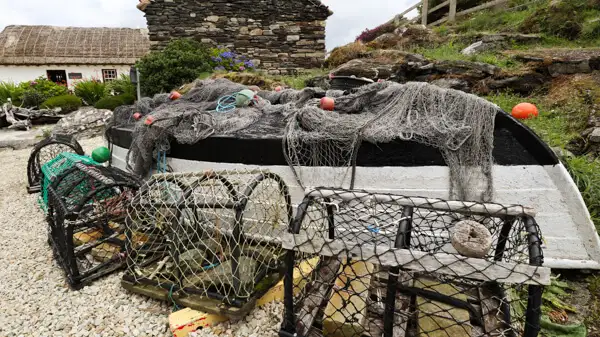
Intro
History is often told as the story of a country’s rulers, princes, nobles and rich people. After all, they had the money to build castles, fortresses and monasteries, to decorate them ornately and thus to create sights for posterity about which there is much to tell.
The Glencolumbcille Folk Village on the west coast of County Donegal proves that history can also be told in a different way. This is about the life of ordinary people in a fishing village in rural Ireland.
The small but very nice open-air museum is a small village. Each cottage tells a story.
Of a time when fishing and farming in the rocky north-west could barely feed the villagers, of a time when there was no electricity, water supply or connection to the telecommunications network in rural Ireland and of a time when an energetic pastor set about improving the living conditions of ordinary people in rural Ireland.
And the history of the little people can be really interesting. I came here more or less by chance on a motorbike ride and then really took my time to look at every cottage – inside and out.
We are originally from Germany and have been living partly in Ireland for many years now (second home). We have travelled the island extensively several times and therefore know it very well.
History of the Glencolumbcille Folk Village
It is sometimes amazing what a big difference a single person can make when they get involved.
In our case, that person is Father James Mc Dyer – or was, as he lived from 1910-1987.
He grew up in the region, studied and worked in various places in Ireland and England and was appointed (Catholic) priest of Glencolumbcille in 1951.
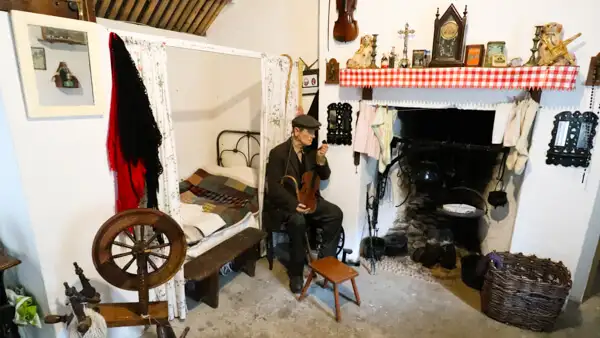
In the middle of the 19th century, the Irish island suffered from the potato blight, which destroyed entire harvests over several years and caused terrible famines. During this time, large numbers of Irish people began to emigrate to the USA and Canada to escape the bitter hardship.
This trend continued until the middle of the 20th century. The country was still poor, in isolated counties such as Donegal there was hardly any work and fishing and farming could hardly feed the people in this harsh landscape. Donegal was long regarded as “the forgotten county”.
Those who didn’t come here, didn’t come here and those who did, often still emigrated to America to build a future for themselves.
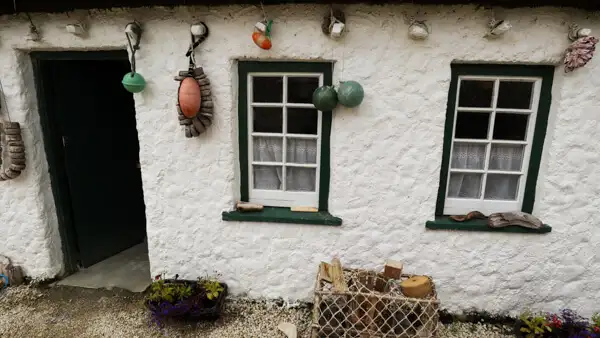
The villages continued to become outdated and impoverished and trade with other counties was modest. Many villages had no centralised water supply or sewage disposal until the 1950s, no electricity and little connection to the better served areas of Ireland, not even by telegraph.
Father Mc Dyer had seen more of the world through his education and he had built up relationships with more influential people in Dublin and London. There, in the capital cities, there was less focus on the rural regions.
He set about organising the people and in the early 60s, together with many volunteers, built the Folk Village. He also built a community centre, a fish factory and many other initiatives. According to the motto: “Helping people to help themselves”, more and more jobs were gradually created for the people and thus a perspective to stay!

Through his connections, he helped to bring electricity, water supply and sewerage to the region and managed to raise awareness of the needs of ordinary people in rural Ireland through public appearances and speeches in Dublin.
The Folk Village is still a small tourist attraction today, which continues to create jobs, as do the many other projects of the enterprising pastor.

A visit to the Folk Village
Just west of the town of Donegal you will find the small village of Glencolumbcille. In Glenclumbcille you will find the Folk Village close to the coast just off the R263. See also the Folk Village website: https://www.glenfolkvillage.com/.
There are a number of small cottages built in different styles – from the simple fieldstone cottage with a reed roof to the pretty little house that houses the village school.
The cottages tell stories from different time periods, over several centuries, right up to the present day.
You can take a guided tour or simply stroll through the village and poke your head into the cottages of your choice. There are information boards everywhere that take you back in time and introduce you to a different aspect of rural life.
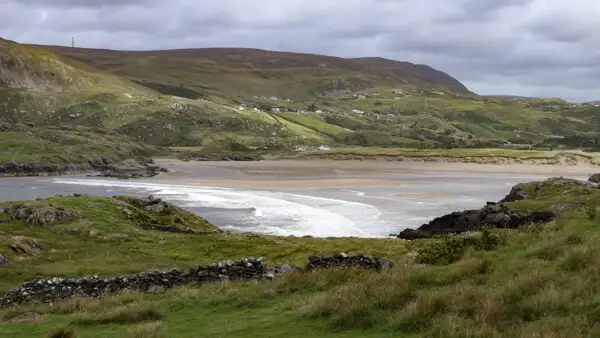
There is also a small café-restaurant in the Folk Village. So you don’t have to go hungry during your visit.
What else is there to do in the area?
Donegal is a pretty harbour town and the main town of the county of the same name. The small castle is nice and it’s also a great place to spend the night.
Following the coast westwards, you come to Bunglass Point, the viewpoint on the cliffs of Slieve League, via Teelin. These are the highest cliffs in Ireland and are even higher than the Cliffs of Moher. You can take a short hike here or simply enjoy the viewpoint.
A little further west you will find the beautiful Silver Strand. The silvery-white sand contrasts sharply with the azure blue sea.
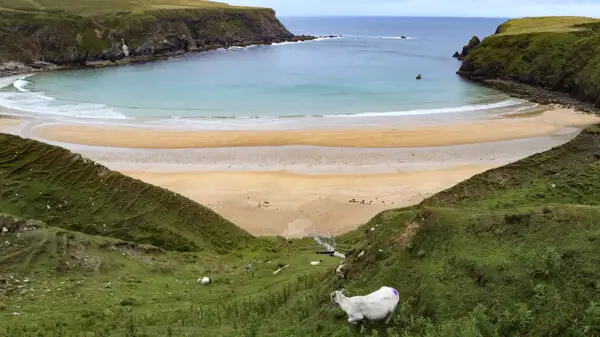
After Glencolumbcille, you can continue via Ardara to Glenties. There you have the choice of travelling into the mountains of Glenveigh National Park or continuing along the coast.
The north coast of County Donegal is also particularly beautiful, especially the Fanad Peninsula and Fanad Lighthouse.
Conclusion
If you are travelling in the north-west of Ireland, Glencolumbcille is definitely worth a detour. The location of the village is wildly romantic and the drive there is a dream if you follow the small roads along the coast.
The Folk Village is a very nice little open-air museum village and, in my opinion, definitely worth a visit. The small cottages on the manageable site are very pretty and each one shows a different part of Irish life over several centuries.
This is about ordinary people in a village on the coast, fishermen, farmers or craftsmen, the village school and the priest, who has managed to bring some infrastructure and, above all, paid work to the poor village communities through a great deal of commitment.
You can combine your visit to Glencolumbcille with your tour of Donegal.
I hope you have lots of fun!
More interesting articles for you
THE CLIFFS OF SLIEVE LEAGUE – MAJESTIC AND MARVELLOUS
DROMBEG STONE CIRCLE – THE MEGALITHIC HERITAGE OF IRELAND
POWERSCOURT HOUSE AND GARDENS
THE LEGENDARY ROCK OF CASHEL
Picture credits cover picture: Glencolumbcille Folk Village, photo: Ulrich Knüppel-Gertberg (www.irland-insider.de, www.ireland-insider.com)